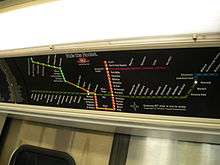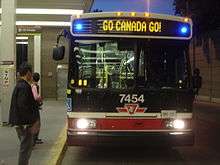Toronto Transit Commission accessibility
Accessibility for people with disabilities on the Toronto Transit Commission (TTC) system is incomplete but improving. Most of the Toronto subway system was built before wheelchair access was a requirement under the Ontarians with Disabilities Act (ODA). However, all subway stations built since 1996 are equipped with elevators, and elevators have been installed in 30 stations built before 1996, including 1 station that was expanded in 2002, Sheppard–Yonge). Over half (47 of 75) of Toronto's subway stations are accessible. In 2014, the TTC began introducing new low-floor vehicles on its streetcar network. These accessible vehicles ultimately replaced the ageing, non-accessible Canadian and Articulated Light Rail Vehicle streetcars by December 29, 2019.[1] In December 2015, the TTC retired the last of its lift-equipped high-floor buses, which were introduced in 1996, making all 170 bus routes 100% low-floor accessible.[2]
Subway
Vehicles

All subway cars, the T1, and Toronto Rocket, offer level boarding for customers with wheelchairs and other accessibility needs. They have priority seating identified in blue, and flip-up benches at designated wheelchair locations in each car. The location of these can be found by an exterior accessible icon beside the door, or on the Toronto Rockets, an additional exterior blue light beside the door.
The T1 series subway cars were the first trains to have:
- wider doorways,
- no centre line vertical stanchion bars.
All trains offer automated audible-only station stop announcements, the Toronto Rocket subway cars have twice the accessible seating compared to the T1 subway cars. The Toronto Rockets have visual displays (showing the next stop along with arrows pointing to which side doors will open on at the next stop) and electronic route maps to assist customers who are hearing-impaired and also verbally announce the side doors will open on at the next stop.
Stations
Accessible stations are equipped with elevators, wide fare gates, and access doors. The TTC provides a phone number, 416-539-LIFT, which provides a recorded message listing any elevators which are out of service.
- All five stations on Line 4 Sheppard, opened in 2002, are fully accessible and equipped with elevators.[3]
- 27 of the 38 stations on Line 1 Yonge–University are accessible:[4]
- 17 of the 31 stations on Line 2 Bloor–Danforth are accessible:[4]
- Two of the five stations on Line 3 Scarborough are fully accessible, while one station is partially accessible:
Planned elevator installation
In a 2015 report the TTC stated that its target of having all stations accessible by 2020 will not be met, and that it cannot make all subway stations accessible by 2025 unless full funding is made available by governments. In March 2017, TTC CEO Andy Byford reaffirmed the agency's commitment to meeting the 2025 goal, pointing out that at one point in its plan, seventeen stations will be under construction simultaneously.[5] The completion plan for elevators in remaining stations is as follows:[6]
- 2020: Bay (construction in progress),[7] Chester (construction in progress),[8] Dupont (construction in progress), Runnymede (construction in progress),[9] Wilson (construction in progress),[10] Yorkdale (construction in progress)[11]
- 2021: Keele (construction in progress),[12] King, Lansdowne (construction in progress),[13] Sherbourne (construction in progress)[14]
- 2022: College, Donlands, Spadina (Line 1)
- 2023: Castle Frank, Christie, Greenwood, High Park, Lawrence, Summerhill
- 2024: Museum, Old Mill, Rosedale
- 2025: Glencairn, Islington, Warden
The remaining inaccessible Line 3 Scarborough stations have been removed from the plans, as Line 3 is expected to be replaced eventually with an extension of Line 2 Bloor–Danforth.
Buses

Since the retirement of the last lift-equipped Orion Vs on December 4, 2015, all 170 bus routes have been 100% accessible,[2] using low-floor buses (Nova Bus LF Series and Orion VII). Not all stops along an accessible route are accessible (in particular, many subway stations where buses terminate are not accessible).
The TTC's low-floor buses are identified by blue lights located on both sides of the front route display.
Wheel-Trans

The TTC provides Wheel-Trans, a door-to-door accessible transit service, to registered clients who are unable to use the conventional transit system. In some cases, Wheel-Trans buses connect customers from their homes to accessible subway stations allowing the rider to use the conventional system for a portion of their journey. The service was created in 1975 as the challenges for people with accessibility needs became more public, and at a time where the entire surface system ran high-floor vehicles which were inaccessible, and subway stations did not have elevators.
Streetcars
As a result of the 2005 Accessibility for Ontarians with Disabilities Act, which requires all public transport services in Ontario to become accessible by 2025, the TTC began to make its streetcar system wheelchair accessible on August 31, 2014, when the first two new low-floor Flexity Outlook streetcars entered service on the 510 Spadina line. The new streetcars have also been used on the 509 Harbourfront since March 29, 2015, and on the 514 Cherry from June 19, 2016, until that route's decommissioning on October 7, 2018. They have also been in operation on the 512 St. Clair since September 3, 2017; the 504 King since January 7, 2018; the 501 Queen since January 6, 2019; the 508 Lake Shore since September 3, 2019; the 506 Carlton since October 13, 2019; the 505 Dundas since April 20, 2020; and the 503 Kingston Road since June 22, 2020.
With the retirement of the last high-floor Canadian Light Rail Vehicle (CLRV) streetcars on December 29, 2019, the entire TTC streetcar fleet consisted of accessible Flexity Outlook vehicles.[1]
Former TTC manager David Gunn criticized the new streetcar order: "[T]hey're not accessible. The floor height is about a foot. You won't be able to load a wheelchair on the street. There will be ramps, but the floor height is going to be about a foot. The ramps will be too steep."[15]
As of June 22, 2020, the new wheelchair-accessible Flexity streetcars can be found on the following routes:[16]
- 501 Queen
- 503 Kingston Road
- 504 King[lower-alpha 1]
- 505 Dundas
- 509 Harbourfront
- 510 Spadina
- 512 St. Clair
Visual impairments
Service animals are allowed on the TTC during all hours of operation.
All stations have yellow warning strips with bumps at the edge of the platforms, and most have tactile floor tiles that assist persons with visual impairments in locating elevators and other accessibility features.
All vehicles are equipped with automated audible stop announcements. Surface vehicles and Toronto Rocket trains also have visual LED stop displays.
In 2015, the TTC tested the new External Route Announcement (ERA) system for buses (similar to the system already in place since 2014 on the Commission's Flexity streetcars), that indicates the route, direction and destination as a pre-boarding announcement.[17] The announcements are made through a speaker located on the outside of the vehicle, when the doors are opened. As of 2019, all TTC surface vehicles as well as all Line 3 and 4 (and some Line 1 and 2) subway trains were equipped with this system in compliance with AODA requirements.
Notes
- Stops along Roncesvalles Avenue are not yet accessible due to platform height issues preventing the accessible loading ramp from deploying.
References
- "TTC's legacy CLRV streetcars reach the end of the line on Dec 29". TTC. November 21, 2019. Archived from the original on November 22, 2019. Retrieved November 22, 2019.
- "TTC All 170 TTC bus routes now 100% low-floor accessible". Toronto Transit Commission. December 5, 2015. Retrieved December 4, 2015.
- "Accessible Transit Services Plan - 2012 Status Report". TTC. Retrieved March 1, 2015.
Table 1: Elevator and Easier Access Installations Completed To Date
- https://www.ttc.ca/About_the_TTC/Commission_reports_and_information/Commission_meetings/2017/April_20/Reports/9_2017_Accessibility_Plan_Status_Report_BR%2018389.pdf
- https://www.youtube.com/watch?v=Ko4SjM_Ep-s
- "Station Completion Schedule". Easier Access Program. TTC. Retrieved October 13, 2018.
- "Bay Station Easier Access Project". TTC. Retrieved October 20, 2019.
- "Breaking ground at Chester Subway Station for elevator access to platform level yesterday". www.twitter.com. Retrieved November 16, 2018.
- "Runnymede Station - Easier Access (Elevator) Project". ttc.ca. Toronto Transit Commission. Archived from the original on March 15, 2019. Retrieved March 9, 2019.
- "Wilson Station - elevator construction". ttc.ca. Toronto Transit Commission. Archived from the original on March 15, 2019. Retrieved March 9, 2019.
- "TTC celebrates opening of new Coxwell Station elevator tomorrow". www.ttc.ca. Retrieved March 9, 2018.
- "Keele Station - Easier Access project". ttc.ca. Toronto Transit Commission. Retrieved September 12, 2019.
- "Lansdowne Station - Easier Access Project". TTC. Retrieved October 20, 2019.
- "Sherbourne Station - Easier Access Project". Retrieved October 20, 2019.
- "TTC Makes Dumbest Decision Ever - Former Head Warns". Theglobeandmail.com. Retrieved February 19, 2012.
- "Accessible streetcar service updates". TTC. July 2, 2019. Archived from the original on July 2, 2019.
- "External Route Announcement Trial". Archived from the original on July 29, 2015. Retrieved July 30, 2015.

_(14918534190).jpg)